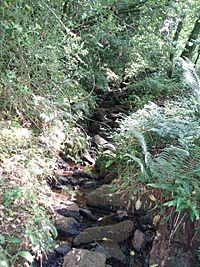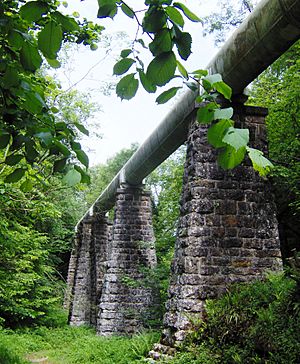Harptree Combe facts for kids
| Site of Special Scientific Interest | |
 |
|
| Area of Search | Avon |
|---|---|
| Coordinates | 51°17′59″N 2°37′52″W / 51.29962°N 2.63106°W |
| Interest | Biological |
| Area | 13.63 hectares (0.1363 km2; 0.0526 sq mi) |
| Notification | 1954 |
Harptree Combe is a special natural area in England. It covers about 13.63-hectare (33.68-acre) of land. It's known as a Site of Special Scientific Interest (SSSI). This means it's a protected place because of its unique plants, animals, or geology. Harptree Combe was first protected in 1954.
The word "combe" or "coombe" is a local term from the West Country of England. It means a valley with very steep sides. This area also has an old aqueduct from the 1800s. Plus, you can see the site of a castle built around the year 1100.
In 2009, a part of Harptree Combe was bought by Alan Sheppard. He paid £60,000 for about 22.67 acres (9.17 ha) of the land. He was only the third owner of this part of the Combe since 1805. The last time it was sold before that was in 1922.
Amazing Plants and Animals
Harptree Combe is a narrow valley made of limestone. It has many different types of natural areas. These include Ash woodlands, grassy fields, and rocky cliffs. There's also a small, marshy stream flowing through it.
This valley wood is very old. It has many different kinds of trees and shrubs. The plants growing on the ground are also special. For example, you can find Herb Paris (Paris quadrifolia). This plant shows that the habitat has not been disturbed for a long time.
Other rare or local plants also grow here. These include Small Teasel (Dipsacus pilosus) and Autumn Crocus (Colchicum autumnale). The limestone rocks and the walls of the aqueduct are home to many types of moss and fern. Some of these, like Rusty Beard-moss (Didymodon ferrugineus) and Brittle Bladder-fern (Cystopteris fragilis), are quite rare in Southern England.
The Old Aqueduct
An aqueduct runs through Harptree Combe. It carries water to Bristol. This aqueduct was finished in 1851. James Simpson was the main engineer who designed it. It is still used today to supply water.
The aqueduct has a wrought iron pipe. This pipe runs underground for about 18 kilometres (11 mi). It goes all the way to the Bristol Reservoirs. But in some places, the pipe comes above ground. Here, it is held up by strong limestone pillars and supports. This aqueduct is probably the oldest example of this type of engineering that is still standing. It has been named a Grade II listed building by English Heritage. This means it's an important historic structure.
Richmont Castle Ruins
The few remaining ruins of Richmont Castle are located just above Harptree Combe. This castle was attacked in 1138. At that time, King Stephen captured it. The castle belonged to Sir William de Harptree. He supported Empress Matilda in a civil war against King Stephen.
King John also visited the castle in 1205. Later, the castle was torn down by its owner, Sir John Newton. This happened during the time of Henry VIII.
In a book from 1929 called Somerset, the authors described the castle. They said it was on a hard-to-reach piece of land at the end of the valley. They called it one of the "lawless strongholds" that caused trouble during King Stephen's time. Today, only a small part of the main tower can be seen overlooking the valley. Some of the old earthworks are still visible, but they are partly covered by plants.




